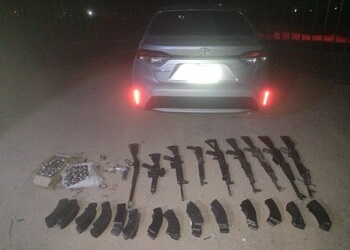A bloody confrontation between the Caborca Cartel and the Chapitos in Sonora, Mexico, has revealed the resilience of Rafael Caro Quintero’s successors as they face down a larger foe.
Seven people were killed and four wounded following an armed confrontation in the municipality of Caborca on March 20, reported the Sonora State Security Bureau (Mesa Estatal de Seguridad del Estado de Sonora).
The Sonora Attorney General’s Office said that the confrontation between “two armed groups” claimed the life of one bystander, in addition to members of the groups.
Meanwhile, local media reported that the two groups were the Chapitos — a faction of the Sinaloa Cartel headed by four sons of now-jailed drug lord Joaquín Guzmán Loera, alias “El Chapo,” — and the Caborca Cartel, once led by the now-jailed Guadalajara Cartel co-founder Rafael Caro Quintero.
The fight had originally begun in the municipality of Rio Asuncion before quickly spreading to “the nearby neighborhoods of Pueblo Viejo, Infonavit, Misiones de Kino,” a delegate of the Sonora Attorney General’s Office stated.
SEE ALSO: El Chapo’s Sons Fight Rafael Caro Quintero’s Men in Sonora, Mexico
El Chapo’s sons have disputed Caborca and the surrounding region with Caborca Cartel since at least 2020. They increased their attacks in July 2022 following Caro Quintero’s arrest, with clashes leading to 28 deaths in the state between July 15 and July 19.
The town has been important for several generations of Mexican organized crime due to its geographic location. It has long been home to drug trafficking routes that formerly carried marijuana and heroin toward the United States from cultivation zones further south in Mexico. Now the same roads carry methamphetamine and fentanyl.
Those synthetic drugs arrive from the states of Jalisco and Sinaloa, Mexico’s primary synthetic drug production zones, which lie directly to Sonora’s south. Precursor chemicals also arrive at the state’s port of Gauymas. The border between Sonora and the US state of Arizona is a popular trafficking point for drugs and humans through the land border, while trafficking by air from Sonora has also become more popular recently.
InSight Crime Analysis
The Chapitos appear to be seeking control over Caborca to dominate the trafficking routes to one of their biggest buyers: the United States. But despite their likely advantage in terms of strength, the Chapitos have so far been unable to drive off the local cartel.
Reports date the creation of the Caborca Cartel to 2017 when Caro Quintero formalized the efforts of his family to dominate select criminal activities in Sonora, but the Caro Quintero family and its allies have a long and entrenched history in the state. The network now known as the Caborca Cartel has controlled one of the main drug trafficking routes to the United States for decades, Jose Montero, a professor at the Tecnologico de Monterrey and a public security specialist, told InSight Crime.
“Although it has not always been called the Caborca Cartel, the group has owned the route from Guaymas to Nogales since the 1980s. They decide who can pass and who can’t,” said Montero.
SEE ALSO: The Three Criminal Fronts Sparking Violence in Sonora, Mexico
The group has an important social base in Caborca, as well as intimate knowledge of the territory, Montero said.
“The Quintero family’s historical presence in the municipality has generated the group’s roots in the area, their control of the territory, and the support of the community,” he said. “Part of this support is due to the group’s ability to offer jobs in the areas where it is present, ranging from contract killings to corruption.”
There is no knowledge on the exact size of the Caborca Cartel, but it focuses on drug transportation rather than multiple criminal economies, helping to avoid conflict, Montero said.
“The cartel has not sought to control the production and distribution of drugs but has specialized in transit,” he said. “It has not directly antagonized other criminal groups and has been able to do business with them.”
In addition, the Caborca Cartel has established strategic alliances with other criminal organizations in Sonora.
One organization is La Línea, a group that once acted as armed enforcers for the Juárez Cartel. It has also allied with Fausto Isidro Meza Flores, alias “Chapo Isidro,” a veteran operator for Beltrán Leyva Organization (BLO), and his associates. This has given the group some additional brawn in facing down its larger rival.
The Chapitos’ battle with Caro Quintero’s successors is unlikely to end soon, since the Chapitos’ need access to Sonora’s trafficking routes to transport the fentanyl the group produces in northern and central Mexico. But while El Chapo’s sons wield superior weaponry and economic power, the group cannot claim to have the same total domination their father once presided over, said Montero.
“The war fronts Chapitos have opened against the Jalisco Cartel New Generation (Cartel Jalisco Nueva Generación – CJNG) and Ismael “El Mayo” Zambada‘s organization represent a disadvantage in the battle for Caborca,” Montero added.

